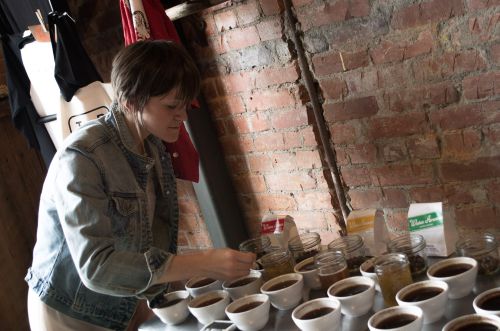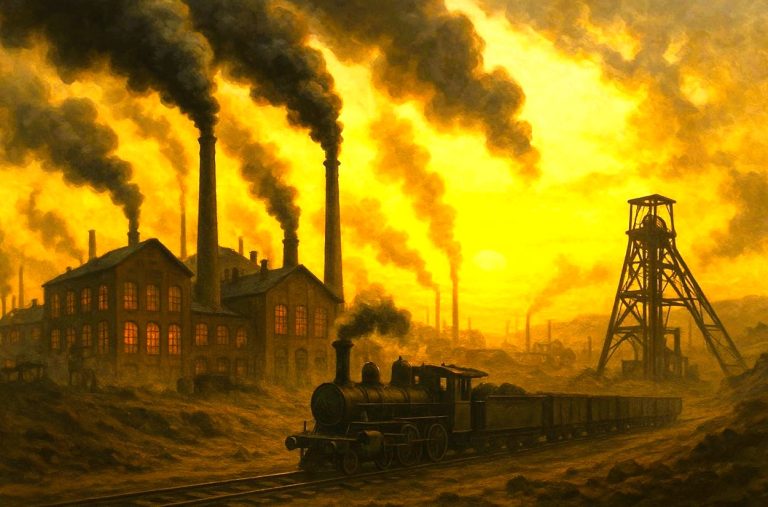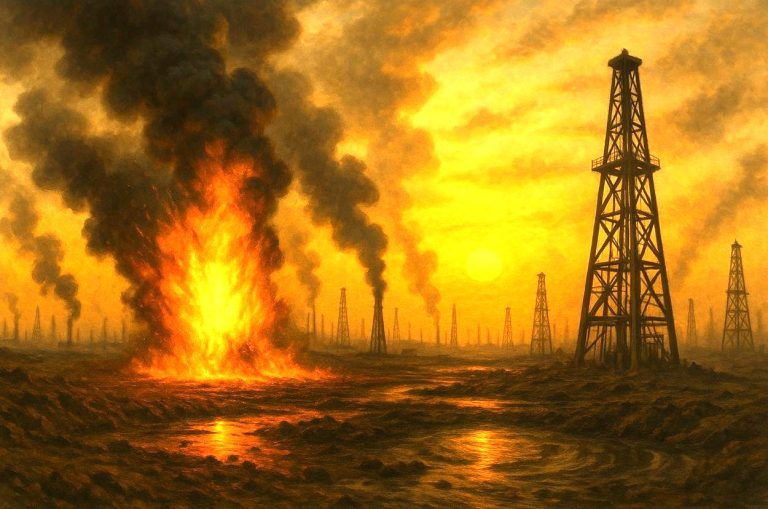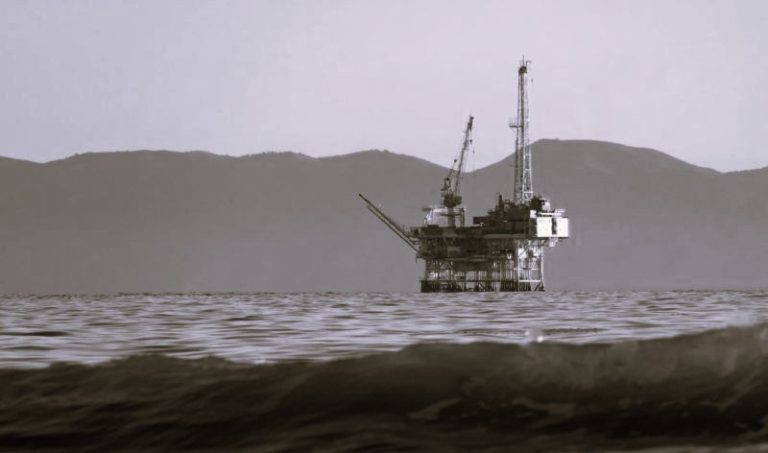

In the steaming cup on the table lies a microcosm of the climate struggle itself. To save coffee is to confront climate change head-on.

By Matthew A. McIntosh
Public Historian
Brewminate
Introduction: A World Awakened by Coffee
Few crops in human history have so thoroughly shaped daily life as coffee. It is not merely a stimulant but a ritual, an axis around which cultures have revolved since its spread from the Ethiopian highlands to the Ottoman court, the London coffeehouse, and finally the global café chains of today. Coffee’s social importance can hardly be overstated: it has served as fuel for revolutions, as the companion of scholarship, and as the quiet mediator of personal reflection. Yet for all its cultural resilience, the plant itself is fragile. Its survival depends on finely tuned ecological balances, and in that dependence lies a profound vulnerability.
Climate change has placed coffee at the intersection of science, economics, and culture. Unlike crops that can tolerate a wide range of conditions, coffee thrives only within narrow climatic parameters. Temperature, rainfall, and altitude combine to create delicate growing zones, microclimates that generations of farmers have learned to cultivate with care. These microclimates are now shifting or vanishing entirely. Scientific studies warn that by mid-century, large swathes of land currently devoted to coffee will become unsuitable, threatening both the drink in our cups and the millions of livelihoods tied to its production.
We can trace the impact of climate change on coffee’s growth and distribution, situating the crisis not only in agricultural terms but also in historical and cultural perspective. Coffee is more than an agricultural commodity; it is a global symbol of human interconnectedness. Its fate offers a microcosm of the broader planetary struggle: whether communities can adapt to new conditions, or whether traditions that have defined centuries of human life will slip into memory.
Climate and Coffee: A Delicate Balance
Coffee’s fragility arises from its evolutionary history. Arabica (Coffea arabica), the variety that dominates global consumption, evolved in shaded, high-altitude forests of East Africa. It prefers average annual temperatures between 18 and 22°C, regular rainfall, and a stable diurnal rhythm of cool nights and mild days. Robusta (Coffea canephora), by contrast, tolerates hotter lowlands and resists certain pests, but it lacks the nuanced flavor profile that has made Arabica the cornerstone of specialty coffee markets.
This narrow ecological niche explains why coffee is so susceptible to climate disruption. A rise of just a few degrees accelerates the ripening process, shortening the period in which beans develop their complex chemistry.
Excessive rainfall or prolonged drought interferes with flowering, while warmer nights encourage the spread of pests. In this sense, coffee serves as a biological litmus test for climate volatility; it reveals stress in the system sooner and more visibly than hardier crops like maize or sorghum.
What makes coffee’s case especially precarious is its genetic bottleneck. Arabica is a hybrid species with low genetic diversity. This lack of resilience magnifies its exposure to environmental stress. Breeding new strains for drought or heat tolerance is far more difficult when the genetic toolkit is limited. The crop that delights in its subtlety is also, tragically, bound to its fragility.
Shifting Grounds: Geographic Redistribution
The maps of coffee’s future are being redrawn before our eyes. Climatic modeling shows that many of today’s prime coffee-growing regions will lose suitability by mid-century. Ethiopia, often celebrated as coffee’s birthplace, faces declines in arable land unless farmers move cultivation further uphill. Brazil, the world’s largest producer, already grapples with erratic rainfall and heatwaves that imperil entire harvests. Vietnam and Colombia, global leaders in Robusta and Arabica respectively, are experiencing similar stressors that challenge both yield and quality.
But as old regions contract, new ones emerge. Warmer conditions are making higher latitudes and altitudes newly viable. Farmers in southern Europe, parts of China, and even California are experimenting with coffee cultivation. This migration of growing zones, however, is not a simple story of substitution. The cultural heritage embedded in Ethiopian or Colombian coffee cannot be transplanted wholesale into new soils. A shift in geography entails a shift in history, identity, and meaning. Coffee’s terroir – the unique interplay of soil, climate, and tradition – risks dilution in the pursuit of survival. Such redistribution also raises questions of equity. Wealthier nations experimenting with coffee cultivation may benefit from climate-driven shifts, while poorer tropical countries, whose economies are deeply tied to coffee exports, may face collapse. The new map of coffee production will thus mirror broader patterns of climate injustice: gains for the already advantaged, losses for the vulnerable.
Yield, Quality, and Flavor Under Stress
Beyond geographic shifts, climate change also reshapes the character of the coffee itself. Rising temperatures accelerate cherry development, reducing the time for sugars and aromatic compounds to form. The result is a cup that is flatter, less complex, and less satisfying. Specialty coffee, which depends on these subtleties, becomes harder to produce under such constraints. Farmers in Central America already report declining cup scores linked directly to heat stress.
At the same time, pests and diseases spread into previously safe regions. The coffee berry borer, once confined to lower altitudes, now thrives in highland zones thanks to warmer nights.
Coffee leaf rust, a fungus that devastated plantations in the nineteenth century, has reemerged with renewed vigor, wiping out farms across Latin America. The economic losses are staggering, but so too are the cultural consequences: entire farming communities, built over generations, collapse under the weight of an invisible enemy.
This dual pressure on yield and quality sets up a paradox. Robusta, hardier under stress, is increasingly incorporated into global blends. Yet this solution comes at the cost of taste, threatening to homogenize coffee culture. A beverage once defined by its diversity of flavor risks becoming standardized and uninspired, a caffeine delivery system stripped of artistry.
Farmers at the Frontline
For all the talk of global markets and shifting climate zones, it is smallholder farmers who encounter climate change most directly. Roughly 70 percent of the world’s coffee is grown by farmers managing just a few hectares of land. Their dependence on stable weather patterns is existential: a single failed harvest can spell financial ruin. In nations where coffee exports represent a significant share of GDP, the collapse of farms translates to broader economic shocks, reverberating far beyond rural communities.
The story of adaptation on the ground is often one of ingenuity constrained by poverty. Some farmers experiment with intercropping, planting shade trees or bananas to stabilize microclimates. Others attempt to move uphill, renting or purchasing plots at higher elevations.
Yet these solutions demand capital, knowledge, and land tenure security, resources that many lack. Women, who make up a large portion of the coffee workforce, often carry disproportionate burdens: managing households while also leading farm adaptation efforts. Their labor sustains both family and crop but rarely receives equivalent recognition or reward.
Generational dynamics compound these pressures. Many younger farmers are leaving coffee behind, migrating to cities or abroad in search of stability.
They inherit not only land but also debt, risk, and uncertainty. As they depart, the continuity of knowledge, centuries of cultivation wisdom, begins to erode. Climate change thus threatens to unravel not only economic systems but also cultural lineages embedded in the act of growing coffee.
The Global Market and Consumer Consequences
Coffee is one of the most traded commodities in the world after oil, a fact that underscores its economic significance. Climate disruptions therefore ripple through global supply chains with speed and intensity. Drought in Brazil or floods in Vietnam can send prices soaring overnight, destabilizing markets from New York to Tokyo. Speculators react to weather reports as much as to currency shifts, and consumers feel the consequences in the rising cost of their daily cup.
The volatility reshapes not only prices but also blends. Roasters may turn increasingly to Robusta to stabilize supply, mixing it into Arabica-heavy products once marketed as premium. While this keeps coffee available on supermarket shelves, it gradually alters consumer expectations of quality. What was once a luxury of nuance, tasting notes of citrus, berry, or chocolate, becomes harder to find outside expensive specialty shops. Such stratification also highlights the asymmetry of climate costs. Consumers in wealthy nations may grumble at higher prices, but they remain insulated from the existential stakes faced by producers. The burden of climate instability falls most heavily on those least equipped to bear it. Coffee thus becomes a case study in global inequity: the pleasures of the privileged maintained at the expense of the precarious.
Adaptation and Innovation
Despite the gravity of the threat, coffee is not without avenues of resilience. Farmers and researchers are experimenting with agroecological methods long known but newly urgent: planting shade trees, diversifying crops, and restoring soil health to buffer against temperature extremes. Such practices reconnect coffee to the forest ecologies from which it first emerged, suggesting that sustainability lies not in extraction but in symbiosis.
Scientific innovation complements these grassroots strategies. Breeders are working to develop new strains capable of withstanding heat, drought, and disease. Some draw from wild coffee species, many of which remain underexplored genetic reservoirs.
Others employ modern tools such as CRISPR to accelerate resistance traits. Yet this scientific frontier comes with challenges: introducing new varieties requires time, testing, and farmer buy-in, all of which are costly and uncertain.
Beyond the farm, systemic innovations are unfolding across the supply chain. Circular economy models repurpose coffee waste as fertilizer, fuel, or even construction material, reducing environmental footprints. Certifications and fair-trade programs channel higher prices to farmers who adopt sustainable practices. Yet these solutions, while promising, are uneven in reach. Too often they benefit farmers with access to global markets, leaving the most marginalized communities behind. The path to adaptation is therefore as much political as it is technical: a matter of equity, investment, and collective will.
Cultural and Ethical Dimensions
Coffee is never just a crop. It is a ritual of morning solitude, an accompaniment to intellectual exchange, a catalyst for political dissent. From Ottoman coffeehouses to Enlightenment salons, from Sufi ceremonies to modern cafés, coffee has woven itself into the very fabric of cultural and political life. To contemplate its decline under climate change is to contemplate a diminishment of culture itself.
The ethical stakes extend beyond nostalgia. If consumers continue to demand cheap coffee without regard for sustainability, they reinforce a system that externalizes costs onto the most vulnerable. To drink coffee in the twenty-first century is thus to make a moral choice. Will consumers pay more to support farmers adapting to new realities, or will they allow coffee to become another casualty of the global climate divide? As Anthropocene Magazine suggests, solutions may already be within reach, but their adoption depends on willingness across the chain, from grower to drinker. Historical parallels remind us that cultural identities can shift when staples falter. The decline of Mediterranean wine regions in antiquity reshaped economies and rituals; the introduction of tea to Britain transformed daily life. Coffee may face a similar inflection point. The question is whether humanity will steward its future with foresight or allow it to drift into scarcity, nostalgia, and loss.
Future Scenarios: Coffee in 2050
Imagining coffee in 2050 yields starkly divergent possibilities. In one optimistic scenario, investment in research and equitable adaptation empowers farmers to thrive in new conditions. Consumers accept higher prices as the cost of sustainability, and global supply chains reconfigure to reward resilience. Coffee remains abundant, diverse, and culturally vibrant.
In a pessimistic vision, climate instability devastates traditional growing regions, forcing mass migration from rural communities. Robusta dominates the market, homogenizing taste and eroding cultural diversity. Specialty coffee becomes the preserve of elites, its origins reduced to boutique niches while mass-market blends deliver little more than caffeine. The very landscapes that once defined coffee’s identity lie abandoned or repurposed.
Most likely, the future will fall between these extremes. Some nations and communities will adapt successfully, while others fade from the map of coffee production. The result will be uneven, marked by both continuity and rupture.
The contours of this future, however, are not predetermined. They depend on choices being made today: choices about research funding, trade structures, consumer behavior, and the recognition of coffee farmers not as faceless suppliers but as partners in a shared heritage.
Conclusion: The Choice Before Us
Coffee’s fate under climate change encapsulates the broader human dilemma. It reveals the fragility of systems we take for granted, the inequities embedded in global markets, and the urgency of adaptation in the face of ecological disruption. To protect coffee is not only to safeguard a crop but to defend a cultural legacy that binds continents and centuries together. The question, ultimately, is whether we will respond to this challenge with the seriousness it deserves. The crisis is not distant; it is already unfolding in the fields of Ethiopia, Colombia, and Brazil. The taste of tomorrow’s coffee depends on the actions of today. Will we invest in resilience, honor the labor of farmers, and reshape our consumption patterns, or will we accept a world where coffee becomes a memory of abundance replaced by a bitter scarcity? In the steaming cup on the table lies a microcosm of the climate struggle itself. To save coffee is to confront climate change head-on, not as an abstraction, but as a matter of taste, livelihood, and culture. The bitter harvest can still be avoided, but only if we choose differently, and choose soon.
Originally published by Brewminate, 09.10.2025, under the terms of a Creative Commons Attribution-NonCommercial-NoDerivatives 4.0 International license.


